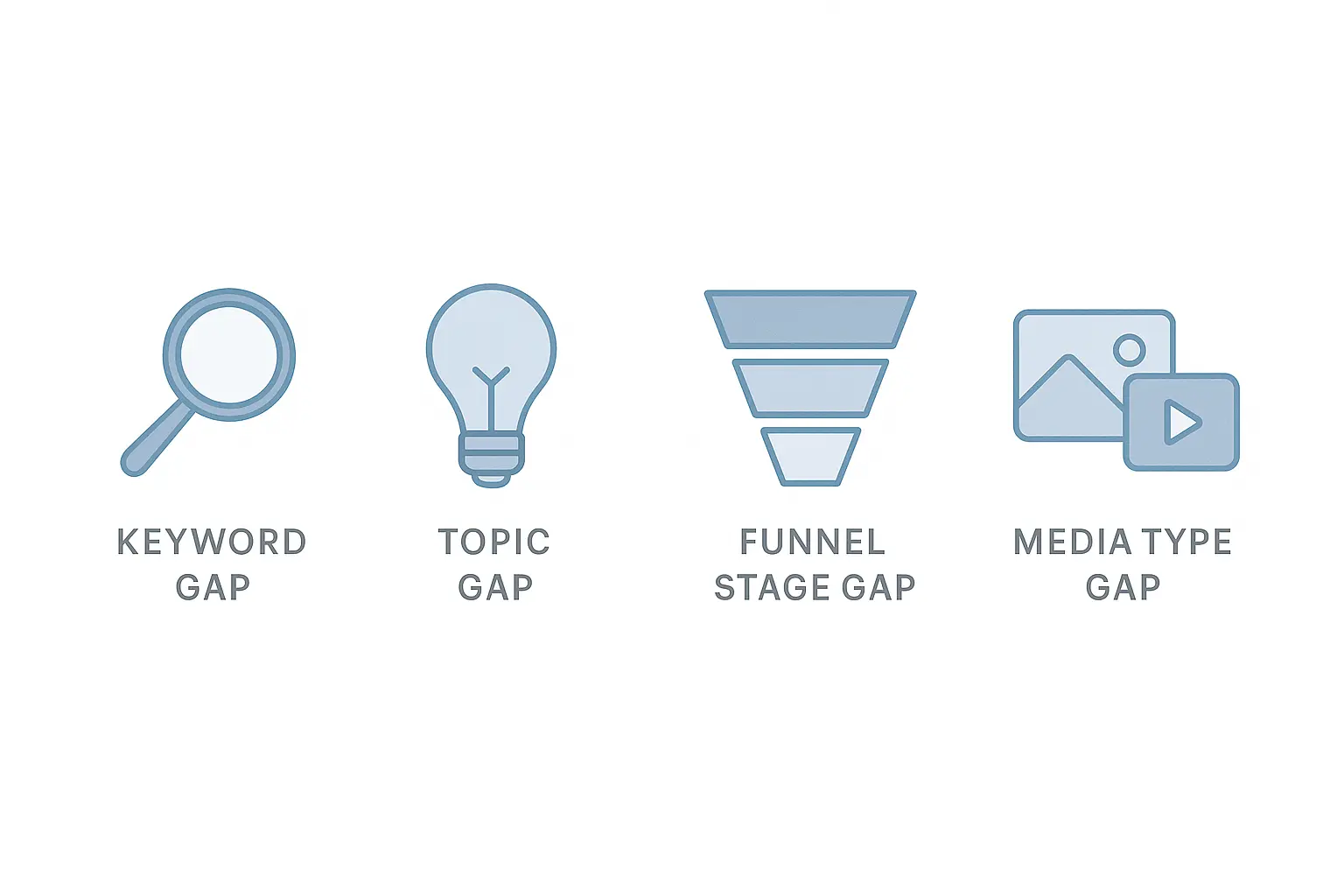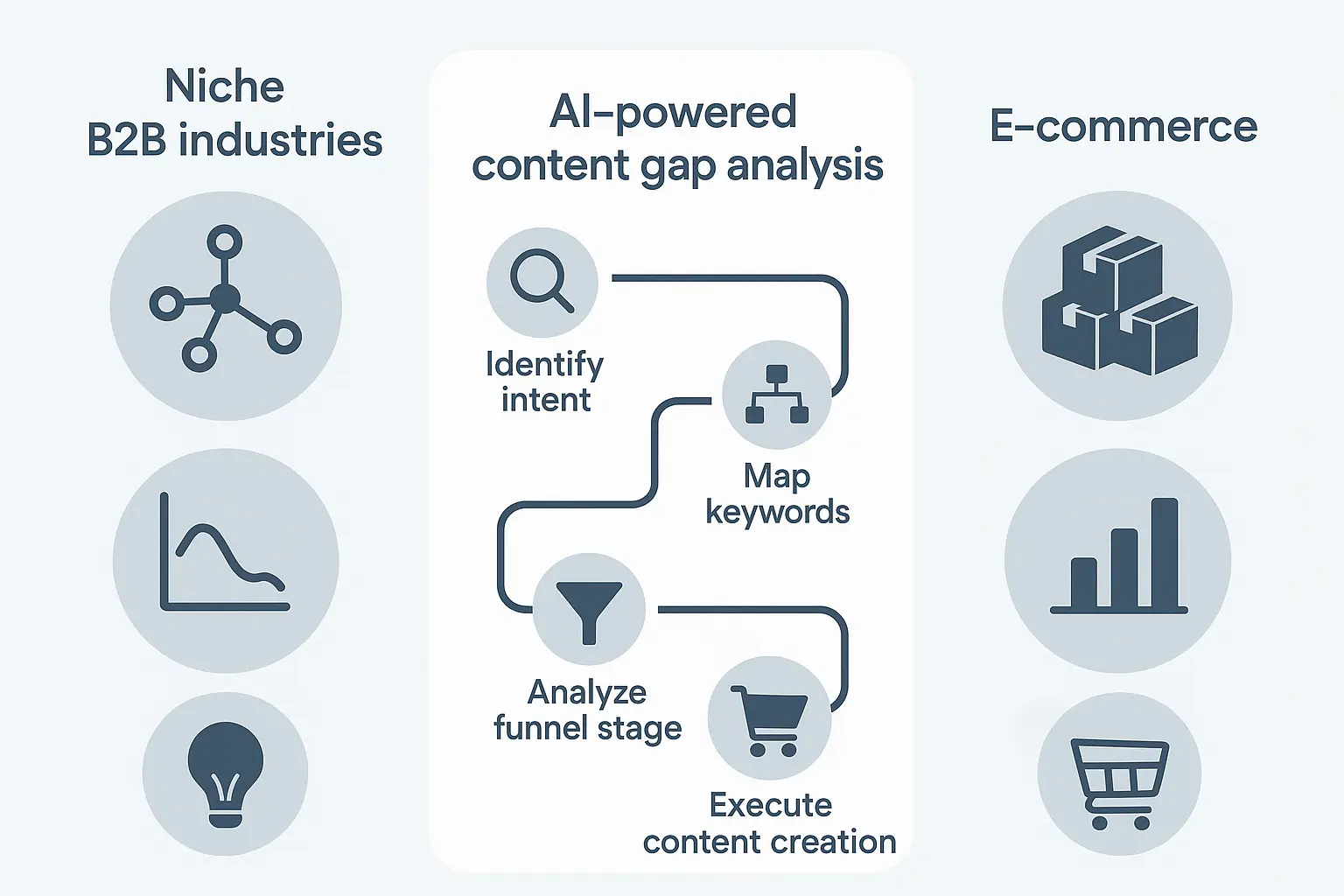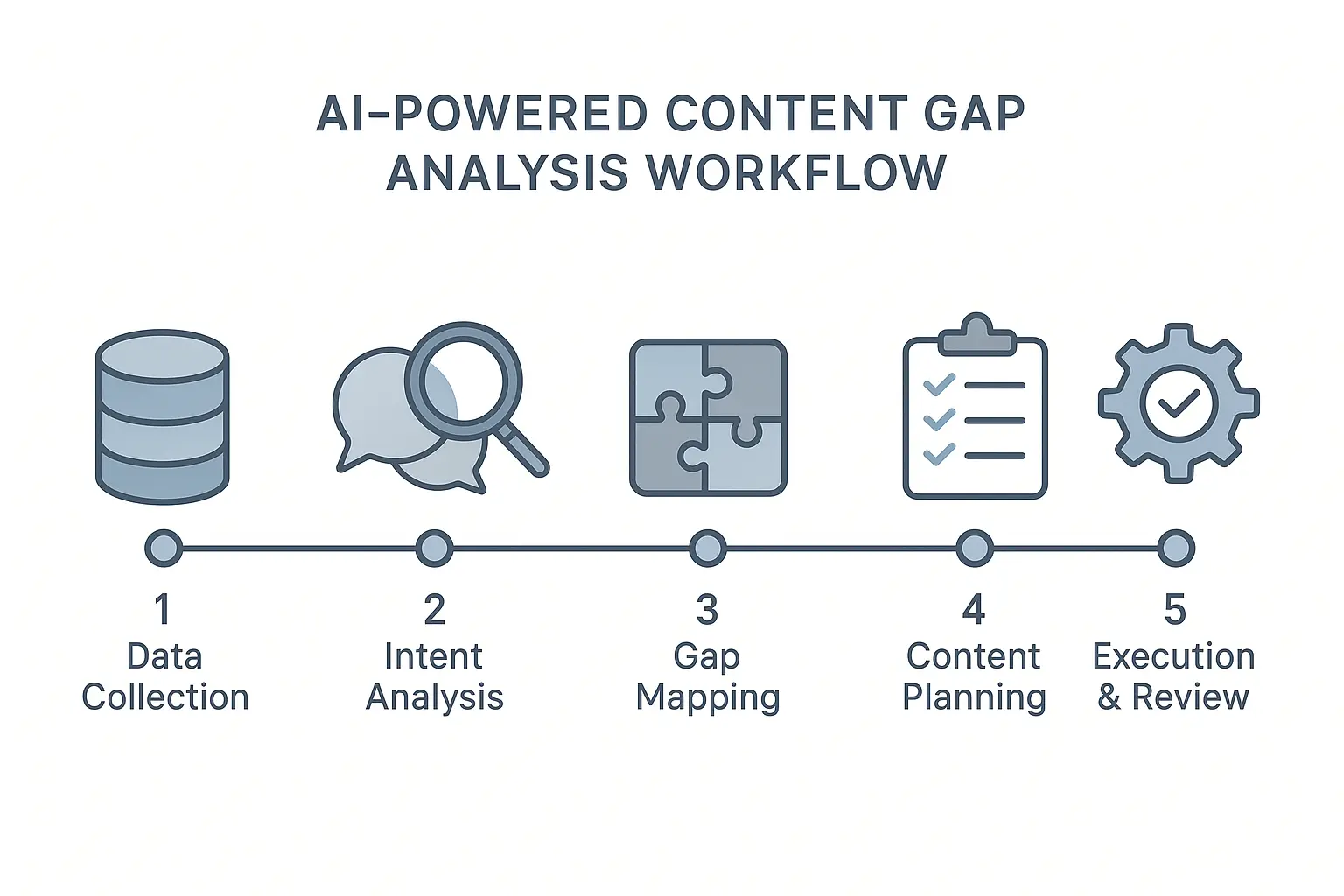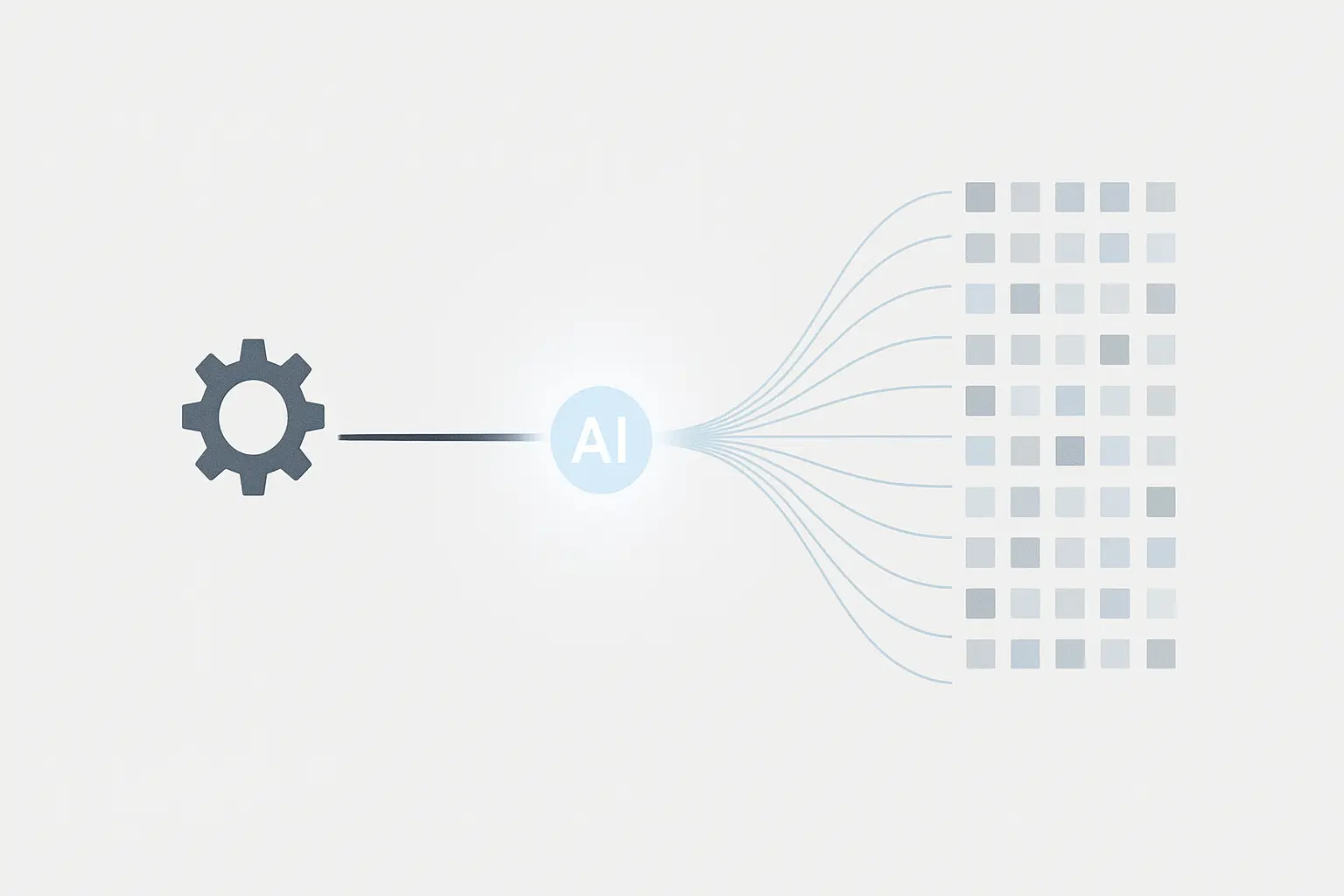You just landed two fantastic new clients. One sells highly specialized cryogenic valves for aerospace engineering. The other runs an e-commerce store with over 5,000 artisanal coffee products.
You’re thrilled. Then, reality hits: how on earth do you build a content strategy that works for both?
One needs to attract a handful of hyper-specific, high-value decision-makers. The other must capture thousands of individual shoppers searching for the perfect roast. Using the same playbook for both is a recipe for wasted effort and frustrated clients.
This is a common challenge for growing agencies. The solution lies in applying the same powerful technology—AI-driven content gap analysis—in two fundamentally different ways.
The Old Playbook is Broken
First, let’s get on the same page. A content gap analysis is the process of finding the gap between what your audience is searching for and the answers your client’s website provides. It’s about finding the missing pieces in their content puzzle.
Traditionally, this involved hours of manually exporting competitor keywords into massive spreadsheets and hunting for patterns. The process was slow, tedious, and often missed the nuances of user intent.
In today’s landscape, where over 70% of marketers are actively investing in content marketing, just “making more content” isn’t enough. You need to create smarter content. That’s where AI changes the game, but only if you direct it properly. It’s not about using one tool for every job; it’s about deploying the right AI methodology for the right business model.

The Niche B2B Client: The AI-Powered Sniper Rifle
For your cryogenic valve client, the audience is tiny and incredibly knowledgeable. A single lead could be worth six or seven figures. Your goal isn’t volume; it’s precision. You’re not looking for thousands of keywords. You’re looking for a dozen high-intent problems.
With this “sniper rifle” approach, an AI-powered strategy for B2B moves beyond competitor keywords to focus on understanding the specific pain points of engineers and procurement managers.
How AI Delivers Precision:
-
Semantic Search Analysis: AI moves beyond simple keywords like “cryogenic valve” to analyze the context of top-ranking content. It identifies recurring themes, technical questions, and comparison points that signal deep expertise.
-
Problem-First Discovery: AI tools can scrape industry forums, Q&A sites like Stack Exchange, and even comments on technical whitepapers to find the exact language your audience uses when they’re stuck. This uncovers queries like, “troubleshooting liquid nitrogen flow control issues at -200°C”—something a standard keyword tool would never find.
-
Uncovering Long-Tail Gold: This approach uncovers long-tail keywords, which research shows have a 3-5% higher click-through rate than generic terms. For niche B2B, these queries represent buyers who are deep in the consideration phase and ready for a solution.
The output isn’t a list of 1,000 keywords. It’s a targeted list of 10-15 highly specific “pain point clusters” that your client can build definitive, expert-level content around.

The High-Volume E-commerce Client: The AI-Powered Smart Bomb
Now, let’s turn to your artisanal coffee client. With thousands of products, targeting individual pain points is impossible. The goal here is scale and comprehensiveness. You need to ensure that for every possible way a customer might search for a coffee product, your client has a relevant page ready to meet them.
This is the “smart bomb” approach: covering a massive area, but with incredible accuracy and organization.
How AI Delivers Scale:
-
Product Feed Ingestion: Instead of manually typing in seed keywords, an AI system ingests the client’s entire product catalog (all 5,000 SKUs) and competitor product feeds.
-
Automated Keyword Clustering: The AI then generates thousands of potential keywords and automatically groups them into relevant categories based on product attributes like origin, roast level, grind size, and certifications (e.g., “fair trade,” “organic”). This turns an unmanageable list of 50,000 keywords into 500 actionable content opportunities.
-
Driving Personalization at Scale: Identifying these gaps allows you to create specific category pages and buying guides that feel incredibly personal. This is crucial, as personalized content recommendations can increase e-commerce conversions by up to 20%. A customer searching for “coarse grind dark roast Sumatran coffee” gets a perfectly tailored page, not a generic “dark roasts” category.
For e-commerce, AI turns chaos into structure. It allows your agency to tackle a massive catalog and find thousands of commercially valuable content gaps without drowning in spreadsheets, making it possible to truly scale SEO services profitably.

The Engine Behind the Strategy: It’s All About Intent
So, how does one technology achieve two such different outcomes? It comes down to two core AI concepts.
The first is Natural Language Processing (NLP). Think of this as teaching a computer to read like a human. It doesn’t just see words; it understands the relationships between them, the sentiment, and the underlying intent. This is how it can tell the difference between a researcher’s question (B2B) and a shopper’s query (e-commerce).
The second is Semantic Clustering—the AI’s ability to group ideas and keywords by meaning, not just by shared words. It knows that “espresso beans” and “best coffee for espresso machine” belong together, even if the phrasing is different. This brings order to both the precision of B2B and the scale of e-commerce.
By leveraging these technologies, agencies can dramatically reduce manual work. Modern platforms show that AI can automate up to 80% of content strategy tasks like research and clustering. This frees up your team to focus on what humans do best: crafting compelling narratives and building client relationships. For a deeper dive, explore our complete guide to SEO automation for agencies.
Frequently Asked Questions (FAQ)
What exactly is a content gap analysis?
It’s the process of identifying topics and keywords that your target audience is searching for, but for which your website lacks relevant content. The goal is to fill those “gaps” to capture more organic traffic.
Why can’t I just use a standard keyword tool for this?
Standard tools are great for brainstorming, but they often lack context. They can’t easily distinguish between a high-value B2B problem and a low-intent informational query. They also struggle to organize thousands of e-commerce keywords into a coherent, scalable structure.
How does AI handle industry-specific jargon in B2B?
Advanced AI models are trained on vast datasets that include technical documents, industry publications, and scientific papers. This allows them to understand specialized terminology and the context in which it’s used, making them far more effective for niche industries.
Isn’t this kind of AI-driven analysis too complex for a small agency?
It might seem that way, but the landscape is changing. The key is to separate strategy from execution. As an agency, your value is in understanding the client’s business model and choosing the right approach (sniper rifle vs. smart bomb). You can then leverage partners or platforms to handle the heavy lifting of the AI analysis. This is a core principle behind models like white-label SEO, where agencies can deliver sophisticated services without building the entire infrastructure themselves.
From Awareness to Action
The next time you onboard two vastly different clients, don’t default to the same old strategy. Pause and ask the critical question: am I hunting for specific, high-value problems, or am I building a comprehensive net to capture broad commercial intent?
By viewing AI-powered content analysis through this lens, you can move beyond generic tactics and start delivering highly effective, tailored strategies that drive real business results—whether it’s for one engineer searching for a valve or thousands of coffee lovers searching for their next favorite blend.

